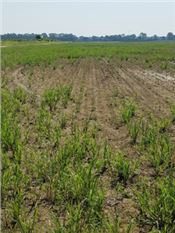Managing Glyphosate-Resistant Barnyardgrass That Is Escaping Clethodim

Barnyardgrass that has escaped glyphosate
and clethodim tankmix
DR. LARRY STECKEL
JACKSON, TENN.
As we announced in February we have confirmed glyphosate-resistant barnyardgrass in Tennessee. Technically the grass species is jungle rice (Echinocloa colona) which is an awnless barnyardgrass species and the primary barnyardgrass species found in southwest Tennessee. The level of glyphosate-resistance was 7 fold in research conducted at Jackson and then confirmed by USDA weed scientist Dr. Vijay Nandula at Stoneville, MS last fall. Dr. Nandula also confirmed the mechanism of glyphosate-resistance (GR) as reduced translocation.
So how do we manage these glyphosate-resistant grass species? What most applicators have done in recent years is to add clethodim to the tankmix. The standard practice for about the past 5 years was to tankmix 4 ozs/A of a 3 lb clethodim product or 6 ozs/A of a 2 lb clethodim in with the glyphosate.
Clethodim has been the backbone for grass control in southwest Tennessee for a number of years. The fear has been what would be “Plan B” if clethodim loses its effectiveness?
That time may have arrived. In the last week I have gotten numerous reports that those rates of clethodim were no longer effective controlling the glyphosate-resistant barnyardgrass in Tipton and Shelby counties. In fact, the two most recent field reports indicated that even the max rates of clethodim (10 oz/A with a 3 lb or 16 oz of a 2 lb clethodim) were not effective on barnyardgrass. So now what?
The main weed control tactic where glyphosate and clethodim are failing to control barnyardgrass is to never let it emerge. Therefore residual grass herbicides like Dual Magnum or Zidua will be very important to use in soybeans that are just emerging. Plan on a two pass of these residual herbicides. Apply one of them Pre emergence and then 21 days later apply a sequential application.
In fields where the barnyardgrass is up with the soybean crop the options are fewer. In Liberty Link soybeans two applications of Liberty applied about 7 days apart would be the best option. In Xtend soybeans the best option would be to switch graminicide chemistries and use Assure or Fusilade. In Xtend soybean do not tankmix a dicamba product in with the Assure or Fusilade as they will likely reduce the grass control those herbicides can provide. ∆
DR. LARRY STECKEL: Extension Weed Specialist, University of Tennessee